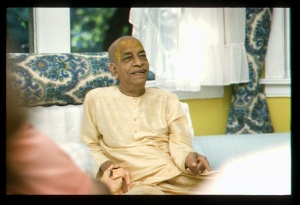SB 9.10.11

A.C. Bhaktivedanta Swami Prabhupada
TEXT 11
- rakṣo-'dhamena vṛkavad vipine 'samakṣaṁ
- vaideha-rāja-duhitary apayāpitāyām
- bhrātrā vane kṛpaṇavat priyayā viyuktaḥ
- strī-saṅgināṁ gatim iti prathayaṁś cacāra
SYNONYMS
rakṣaḥ-adhamena — by the most wicked among Rākṣasas, Rāvaṇa; vṛka-vat — like a tiger; vipine — in the forest; asamakṣam — unprotected; vaideha-rāja-duhitari — by this condition of mother Sītā, the daughter of the King of Videha; apayāpitāyām — having been kidnapped; bhrātrā — with His brother; vane — in the forest; kṛpaṇa-vat — as if a very distressed person; priyayā — by his dear wife; viyuktaḥ — separated; strī-saṅginām — of persons attracted to or connected with women; gatim — destination; iti — thus; prathayan — giving an example; cacāra — wandered.
TRANSLATION
When Rāmacandra entered the forest and Lakṣmaṇa was also absent, the worst of the Rākṣasas, Rāvaṇa, kidnapped Sītādevī, the daughter of the King of Videha, just as a tiger seizes unprotected sheep when the shepherd is absent. Then Lord Rāmacandra wandered in the forest with His brother Lakṣmaṇa as if very much distressed due to separation from His wife. Thus He showed by His personal example the condition of a person attached to women.
PURPORT
In this verse the words strī-saṅgināṁ gatim iti indicate that the condition of a person attached to women was shown by the Lord Himself. According to moral instructions, gṛhe nārīṁ vivarjayet: when one goes on a tour, one should not bring his wife. Formerly men used to travel without conveyances, but still, as far as possible, when one leaves home one should not take his wife with him, especially if one is in such a condition as Lord Rāmacandra when banished by the order of His father. Whether in the forest or at home, if one is attached to women this attachment is always troublesome, as shown by the Supreme Personality of Godhead by His personal example.
Of course, this is the material side of strī-saṅgī, but the situation of Lord Rāmacandra is spiritual, for He does not belong to the material world. Nārāyaṇaḥ paro 'vyaktāt: Nārāyaṇa is beyond the material creation. Because He is the creator of the material world, He is not subject to the conditions of the material world. The separation of Lord Rāmacandra from Sītā is spiritually understood as vipralambha, which is an activity of the hlādinī potency of the Supreme Personality of Godhead belonging to the śṛṅgāra-rasa, the mellow of conjugal love in the spiritual world. In the spiritual world the Supreme Personality of Godhead has all the dealings of love, displaying the symptoms called sāttvika, sañcārī, vilāpa, mūrcchā and unmāda. Thus when Lord Rāmacandra was separated from Sītā, all these spiritual symptoms were manifested. The Lord is neither impersonal nor impotent. Rather, He is sac-cid-ānanda-vigraha (BS 5.1), the eternal form of knowledge and bliss. Thus He has all the symptoms of spiritual bliss. Feeling separation from one's beloved is also an item of spiritual bliss. As explained by Śrīla Svarūpa Dāmodara Gosvāmī, rādhā-kṛṣṇa-praṇaya-vikṛtir hlādinī-śaktiḥ: the dealings of love between Rādhā and Kṛṣṇa are displayed as the pleasure potency of the Lord. The Lord is the original source of all pleasure, the reservoir of all pleasure. Lord Rāmacandra, therefore, manifested the truth both spiritually and materially. Materially those who are attached to women suffer, but spiritually when there are feelings of separation between the Lord and His pleasure potency the spiritual bliss of the Lord increases. This is further explained in Bhagavad-gītā (BG 9.11):
- avajānanti māṁ mūḍhā
- mānuṣīṁ tanum āśritam
- paraṁ bhāvam ajānanto
- mama bhūta-maheśvaram
One who does not know the spiritual potency of the Supreme Personality of Godhead thinks of the Lord as an ordinary human being. But the Lord's mind, intelligence and senses can never be affected by material conditions. This fact is further explained in the Skanda Purāṇa, as quoted by Madhvācārya:
- nitya-pūrṇa-sukha-jñāna-
- svarūpo 'sau yato vibhuḥ
- ato 'sya rāma ity ākhyā
- tasya duḥkhaṁ kuto 'ṇv api
- tathāpi loka-śikṣārtham
- aduḥkho duḥkha-vartivat
- antarhitāṁ loka-dṛṣṭyā
- sītām āsīt smarann iva
- jñāpanārthaṁ punar nitya-
- sambandhaḥ svātmanaḥ śriyāḥ
- ayodhyāyā vinirgacchan
- sarva-lokasya ceśvaraḥ
- pratyakṣaṁ tu śriyā sārdhaṁ
- jagāmānādir avyayaḥ
- nakṣatra-māsa-gaṇitaṁ
- trayodaśa-sahasrakam
- brahmaloka-samaṁ cakre
- samastaṁ kṣiti-maṇḍalam
- rāmo rāmo rāma iti
- sarveṣām abhavat tadā
- sarvoramamayo loko
- yadā rāmas tv apālayat
It was actually impossible for Rāvaṇa to take away Sītā. The form of Sītā taken by Rāvaṇa was an illusory representation of mother Sītā—maya-sītā. When Sītā was tested in the fire, this māyā-sītā was burnt, and the real Sītā came out of the fire.
A further understanding to be derived from this example is that a woman, however powerful she may be in the material world, must be given protection, for as soon as she is unprotected she will be exploited by Rākṣasas like Rāvaṇa. Here the words vaideha-rāja-duhitari indicate that before mother Sītā was married to Lord Rāmacandra she was protected by her father, Vaideha-rāja. And when she was married she was protected by her husband. Therefore the conclusion is that a woman should always be protected. According to the Vedic rule, there is no scope for a woman's being independent (asamakṣam), for a woman cannot protect herself independently.